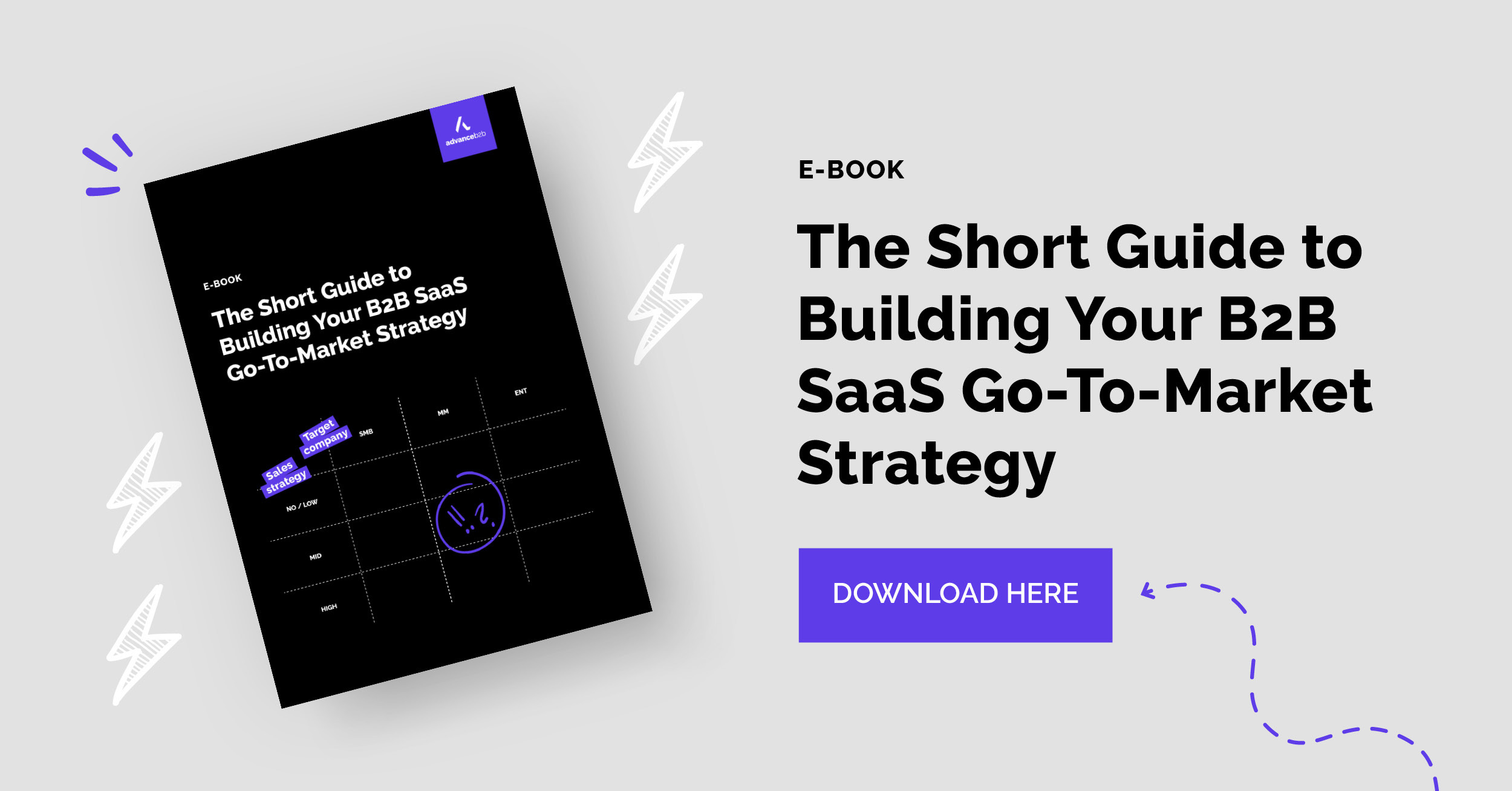“At my signal, unleash hell”, whispered General Maximus, as he led the Roman army into battle in the opening scene of Ridley Scott’s 2000 epic, Gladiator. Upon horseback, Maximus then departed from the frontline to circumnavigate the entire battlefield and meet with the waiting cavalry who were positioned behind the enemy.
When ready they fired a flaming arrow into the sky instructing the Roman Legion to launch their assault. The army then loosened arrows and released catapults to inflict damage on the enemy before the front line of centurions began their advance in perfect formation. Faced with the might of Rome, the depleted army of Germania entered into hand-to-hand combat, only to then discover the Roman cavalry - led by General Maximus - attacking from behind. They were surrounded...
The army of Germania was outmatched in numbers, but more crucially, they were out-thought in strategy.
The SaaS go-to-market strategy of a B2B company is in many ways similar to the battle strategy of the Roman army; a well-thought-out plan of attack will greatly increase your chances of survival, and ultimately, victory.
For SaaS companies, if we break this down into its most simplistic form, it’s about clearly defining who you are selling to and how you will sell to them.
One of the biggest mistakes a SaaS company can make is thinking they can sell to everyone, which ultimately means you sell to no one. At the cornerstone of your go-to-market strategy is the important decision of who you are going to sell to and how.
This is something we have been discussing, reading, and thinking a lot about. It all started when we were attempting to develop a framework in which we could categorize various B2B SaaS companies based on their sales strategy and target buyers.
We scribbled a little matrix on a piece of paper to visualize the situation and this scribble has now evolved into something bigger, something which we now call The Mission Matrix.
(Psst: If you're interested in this topic, stay tuned for more and subscribe to our Advance Insider newsletter to make sure you won't miss any future posts!)
The Mission Matrix: Building the ultimate B2B SaaS go-to-market strategy
We at Advance B2B want to share it with you to help ensure that your B2B SaaS company is selling to the right target in the right way with the right price and through the right channels.
Whether you’re an early-stage startup or an established SaaS company, The Mission Matrix will help ensure that you’re strategically well placed for success, or it will highlight if you are in a position of danger, and more crucially, what you can do to alter your strategy to avoid failure.
In this blog post you will:
- Get to know The Mission Matrix and the seven SaaS missions
- Understand where you are located in the matrix - i.e. are you on a good, bad, or ugly mission
- Learn how you can alter your strategy to move from a position of danger to strength
- See The Mission Matrix in action through a case example of the marketing automation field
- Understand how you can use The Mission Matrix to differentiate from your competitors
- Get a step-by-step checklist to ensure you are well-positioned for sustainable SaaS success
And by the way, if you truly have a passion for go-to-market strategies, you should also check out our short guide to building your B2B SaaS go-to-market strategy
Okay, all set? Let's get back to business.
The Fallacy Of Product-Market Fit
The Mission Matrix begins with the one concept that many SaaS founders start with; product-market fit. But the problem is that product-market fit is something we’ve been looking at from the wrong perspective.
Brian Balfour, CEO of Reforge and one of the top SaaS thought-leaders, is leading the charge for change as he feels we need to approach this the opposite way around, that being market-product fit. By swapping the position of the words we’re building SaaS companies that start off with a problem (i.e. the market) and not a solution (i.e. the product).

The old way of looking at a product serving a market is too simplistic and Balfour argues that we need to look at the bigger ecosystem including channels (how you acquire new customers) and models (business model and pricing).
And that’s exactly right, and it’s also partly what The Mission Matrix is built upon (more on this later), but this is something you need to keep at the forefront of your mind as we introduce and go through the model.
As well as Balfour’s thoughts on market-product fit, The Mission Matrix builds upon some previous theory developed by Guillaume Lerouge regarding go-to-market strategies for B2B SaaS companies, and it also takes elements from Christoph Janz’s 5 Ways To Build A 100 Million Dollar Business framework.
However, here we aim to present a more holistic model to help companies identify whether they are in a position of strength or vulnerability, alongside means of how to transition from poor strategic positioning to a more sustainable and successful strategy.
This more holistic model is The Mission Matrix.
The Mission Matrix
The Mission Matrix is a framework to map out your go-to-market battle plan. It’s built upon a 3x3 grid that combines your possible sales strategy with possible target company.
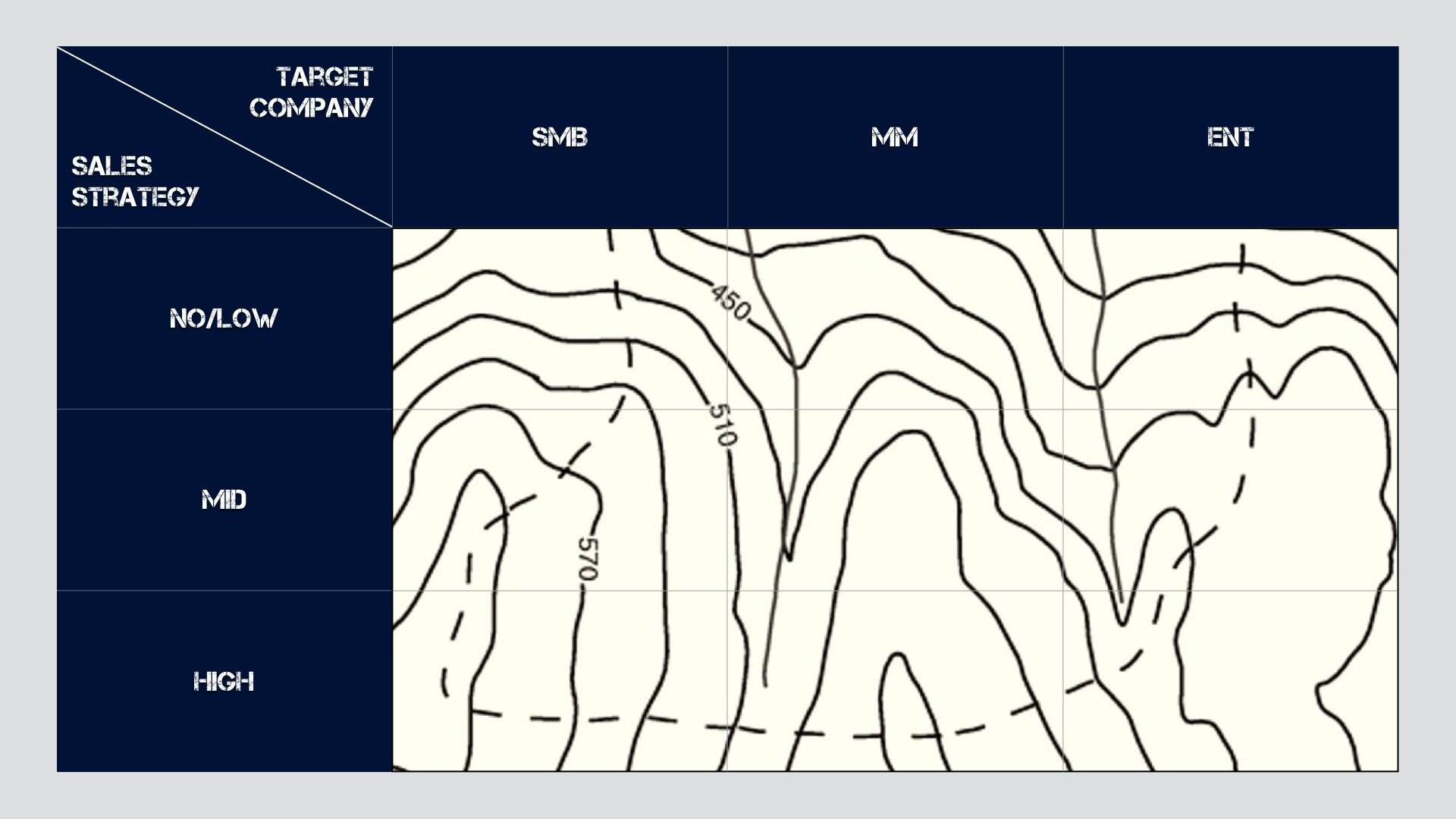
The first question you need to ask is, who are we trying to sell to? You pretty much have three options when it comes to B2B SaaS sales and those are:
- Small and medium-sized businesses (SMB)
- Mid-Market (MM)
- Enterprise (ENT)
These options are listed along the top of the model.
Then secondly, you need to ask, how are we planning to sell to them? Again, in B2B SaaS you essentially have three options:
- No/Low-Touch (Self Service)
- Medium-Touch (Inside Sales/Partnerships)
- High-Touch (Enterprise Sales)
These are listed down the side of the model.
This results in multiple combinations of sales strategy and target company, of which we have identified seven different missions we can embark upon.
As you will discover, some of these have a higher chance of success, and some have a very high chance of failure. We have categorized these missions into three groups, the good, the bad, and the ugly.
Let’s now work through all the different missions you can take, starting with those good strategies that will maximize your chances for success. Afterward, we will look at the bad strategies (read: deadly) alongside actions you can take to move into a position of safety. And finally, we will look at the downright ugly...
The Good Missions
1. Turkey Shoot
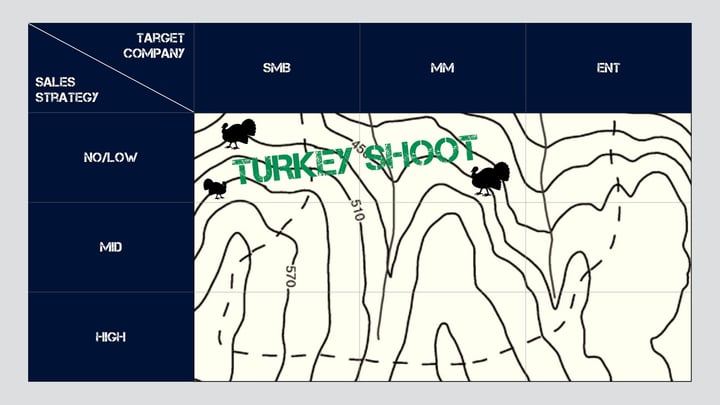
- Sales Strategy = No/Low-Touch
- Target Company = SMB to Mid-Market
- ARPA = Low/Mid
- CAC = Low
- Volume = High
Mission Objective
A high volume of customers who purchase through a self-service platform for a low-price and with a low-cost acquisition.
Mission Overview...
Don’t be deceived by the name, this is by no means an easy mission. However, if you’re able to execute well, then a no or low-touch sales process that has been highly automated and enables your SMB and mid-market customers to make self-service purchases will provide a solid strategic foundation for you to grow your SaaS company.
In this instance, your product is your best sales rep so the success of your company will be heavily tied to the value and performance of your product.
In addition, you must ensure that your customers are able to quickly extract the value of your offering whilst enabling them to deliver referrals to grow your viral coefficient; a service that benefits from the Network Effect will also increase your chances of success here. This viral loop can be supported with inbound marketing to gain the benefits of all that it encompasses; content, PPC, SEO, automation, social, and an efficient growth funnel.
You may have more chances of success focussing on a high volume of deals targeting SMBs and if you target mid-market companies then be prepared to borrow some tactics from the mid-touch sales playbook (coming up soon), which will require human support beyond the direct self-service model.
Growth Tactics
- High viral coefficient of your product
- Freemium model
- Quick time to value
- Highly effective yet efficient onboarding processes
- Broad value proposition that speaks across verticals
- High Network Effect
- Inbound Marketing
- Automate everything
Companies on a Turkey Shoot Mission:
[PODCAST] Turkey Shoot Story >> How Typeform went from private beta to +$10M in ARR with Pedro Magriço, Director of Growth at Typeform
2. Eagle's Nest
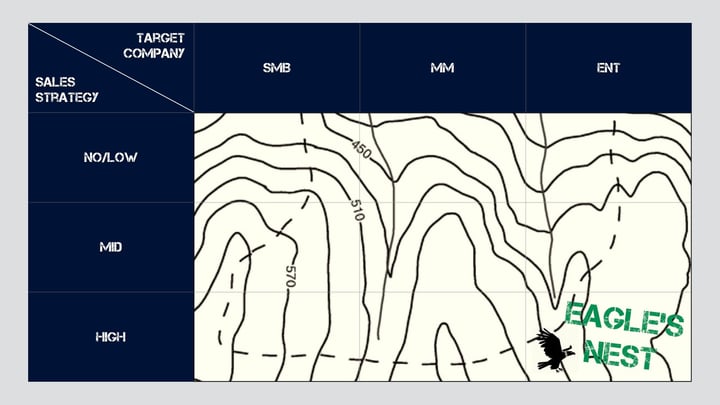
- Sales Strategy = High-Touch
- Target Company = Enterprise
- ARPA = High
- CAC = High
- Volume = Low
Mission Objective
A low volume of large enterprise customers with high ARPA who purchase after a long sales cycle involving people from both organizations.
Mission Overview...
Taking on the Eagle’s Nest is a long and challenging mission, but there are great rewards waiting for those who can accomplish it.
Firstly, a product or tool won’t cut it here so you need to think solution from day one. That means a highly customizable offering that can be tailored to match the exact needs of each particular customer.
You will need to identify the decision-makers within your target organizations and focus all your marketing efforts on landing a sales manager in the same room as these people (note the use of plural).
That means a strongly aligned marketing and sales unit with a marketing team that is capable of delivering highly qualified leads to your sales managers so they can follow up and convert opportunities into customers.
Churn is a vital metric in SaaS and it is typically given as a percentage. However, percentage-based churn can be a misleading metric when operating in the enterprise SaaS space since one big customer churning may not greatly alter your churn %, but it could have a significant effect on your ARR. As a result, be aware of the different types of churn and make sure you also monitor actual dollar churn.
Growth Tactics
- Clearly identified ideal customer profiles built around the key decision-makers within your target organizations
- A highly effective inbound marketing machine powered by excellent content marketing
- A strong and growing pipeline stretching across the entire funnel all the way from contacts to customers
- Outbound sales
- Relationship and trust-building
- Patience and persistence
Companies on an Eagle’s Nest Mission:
[PODCAST] Eagle's Nest Story >> How Slack modified its marketing strategy when going upmarket and targeting Enterprise customers with Bill Macaitis, former CMO at Slack
3. Middle Mission
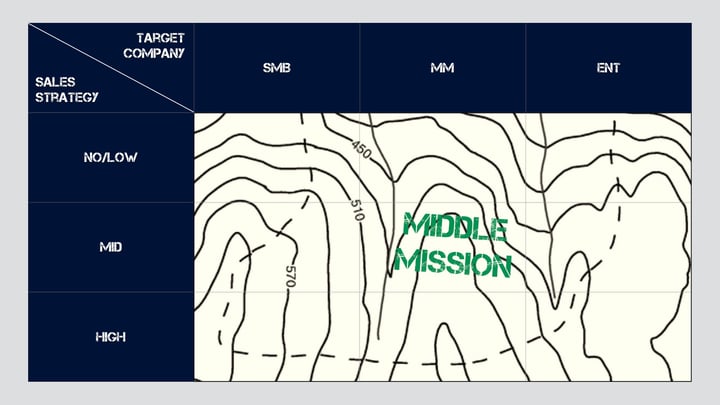
- Sales Strategy = Mid-Touch
- Target Company = Mid-Market
- ARPA = Mid
- CAC = Mid
- Volume = Mid
Mission Objective
Mid-market customers who purchase at a mid-level price point through a combination of automated self-service sales or with the support of a person, either an internal member of your sales team or via an external partner.
Mission Overview...
The Middle Mission got its name not only because it’s located right in the center of the matrix, but also because it requires a careful balance of all components; you need a mid-touch sales strategy to target mid-market organizations who will have a mid-level ARPA and a mid-level CAC.
One of the keys to success is developing a growth funnel that combines just the right amount of automation with a helping hand from your sales and customer success teams along the way.
The Middle Mission is a viable strategy, but you need to ensure there is a market-product fit for your offering otherwise you run the risk of straddling; you’re not fully satisfying the needs of a Turkey Shoot nor an Eagle’s Nest.
Growth Tactics
- A hybrid sales strategy that can provide both automated self-service and human support from your sales and customer success teams
- An automated onboarding process with a scalable and comprehensive customer success solution
- Free Trial
- Inbound Marketing
- Inside Sales
- Partnerships and Partner Programs
Companies on a Middle Mission:
[PODCAST] Middle Mission Story >> How HubSpot acquires & monetises freemium SaaS customers with Kieran Flanagan, VP of Marketing at HubSpot
The Bad Missions
4. Mission Impossible
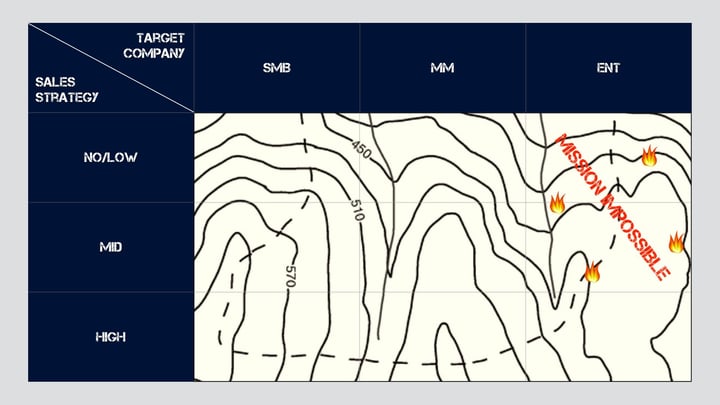
- Sales Strategy = No/Low to Mid-Touch
- Target Company = Enterprise
- ARPA = High
- CAC = Low/Mid
Mission Objective
Sell to large enterprise organizations through a self-service platform for a high ARPA and low to mid-CAC.
Mission Overview...
If you’re trying to sell to enterprise-level customers through a no/low or mid-touch sales process then you are attempting mission impossible. It’s a potentially dream scenario since you’d have a High ARPA customer with a very low CAC.
But if it were possible then everyone would be doing it.
The problem is that enterprise organizations have long and slow buying processes that require relationship building, discussions with multiple people, and in general a lot of human interaction.
Now you could well have a product that serves a need within the enterprise market, so you may have product-market fit, but If we return to the earlier point about market-product fit, then that doesn’t exist.
The reason is that your ecosystem is not in balance. The enterprise sales playbook doesn’t facilitate the tactics that work in a no/low-touch or even mid-touch sales process (think direct self-service, limited customer success support, and a product built for high viral coefficients).
This mission is called Mission Impossible for a reason, so the longer you pursue this strategy then the slower and more painful your failure will be.
How can I escape Mission Impossible?
If you’ve set out on Mission Impossible then not all hope is lost, you have a few ways out.
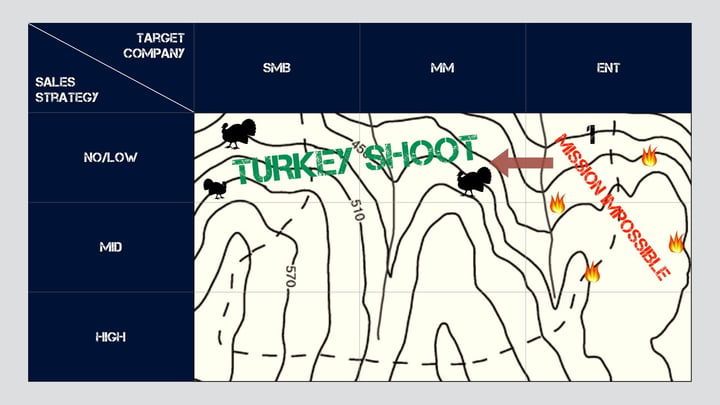
If you’re located in Position 1 then you are in the most impossible of impossible missions (no/low-touch sales to enterprise organizations) and the easiest way out is to slide down to the left to the Turkey Shoot.
Here you can keep your sales and acquisition channel strategies but you need to alter your focus to the mid-market at the very least.
Your product and pricing must be in harmony with this new focus since enterprise-level pricing for SMB to mid-market companies won’t work.
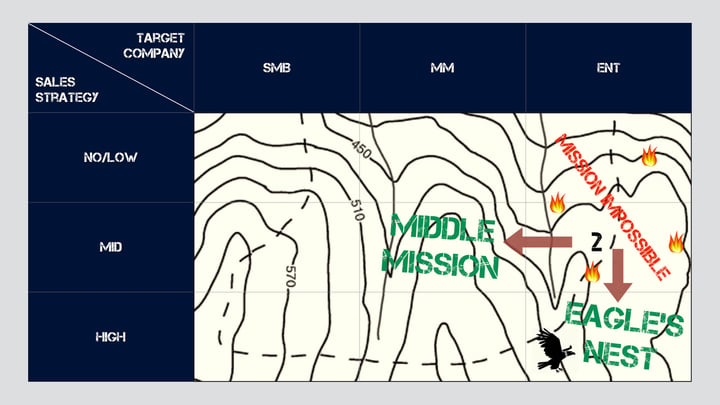
If you’re located in Position 2 and are already applying mid-touch sales strategies to target enterprise customers then you have two options.
Firstly, you could shift your focus to mid-market customers, apply the same sales strategies, and embark upon the Middle Mission. Or secondly, you would need to invest more and ramp-up to enterprise sales.
This means altering your offering from a product to a solution with a high degree of tailoring required for each sale, as outlined in the Eagle’s Nest mission.
So if you find yourself pursuing Mission Impossible then you have three potential ways to pivot and ensure you are building a SaaS company with a much higher chance of success; you just need to decide which path you will take.
5. No Man's Land
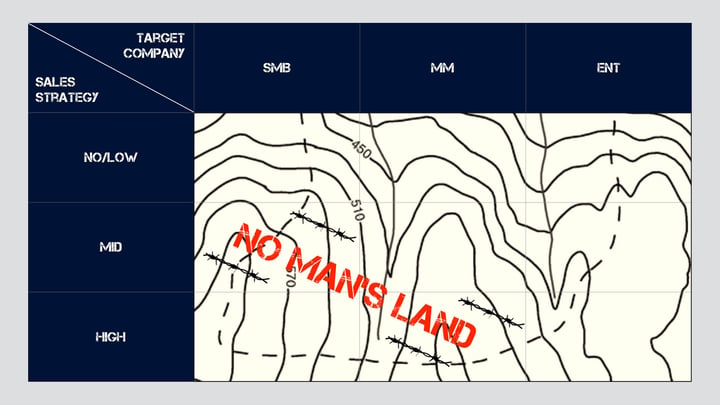
- Sales Strategy/Target Company = Mid-Touch to SMB or High-Touch to Mid-Market
- ARPA = Mid to High
- CAC = Mid to High
Mission Objective
There are two possible missions here. Firstly, sell to SMBs through a mid-touch sales process or sell to mid-market through a high-touch sales process.
Mission Overview...
It’s called No Man’s Land because no one is here. It’s a barren wasteland of SaaS failure since the sales strategies are poorly aligned to the target organizations.
Firstly, targeting SMBs with anything more than a self-service model is not a sustainable business. The volume of accounts you need is too high to support any mid-touch sales processes that require a sales team closing deals.
Secondly, a high-touch enterprise sales approach is not necessary when targeting the mid-market. In addition, the costs of setting up and maintaining an all-star sales team will outweigh the revenue generated from the mid-market deals since the amount required is greater than the number a team of people can sell.
Your market-product fit ecosystem is completely out of balance since the customer acquisition channels do not match the market you are targeting. This in turn will have an effect on your pricing, meaning your model will also be out of balance with your product, market, and customer acquisition channels.
If you are in No Man’s Land then you need to get out. Quickly.
How can I escape No Man’s Land?
Both positions in No Man’s Land have two ways out.
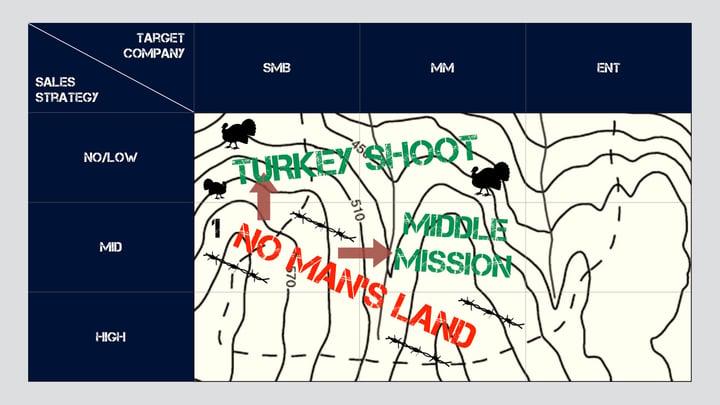
If we start with Position 1 then you can lower your price point and sales strategy to target SMBs via self-service. Secondly, you could shift your focus to the mid-market and maintain your mid-touch sales processes with mid-level ARPA.
If we refer back to the article about Brian Balfour that we mentioned at the beginning of the article (scroll down to section 4, Rethink How Your Models Fit Your Target Markets), this is the exact challenge he had when working at HubSpot, a classic Middle Mission SaaS company.
Brian and his team were responsible for launching Sidekick, a sales tool add-on, but they went with a freemium model that had an entry-level tier that was priced too low. As a result, they ended up attracting low ARPA SMBs via their mid-touch model, which was not in line with HubSpot’s target of mid-ARPA mid-market customers. Their ecosystem was out of balance and as a result, they were stranded in No Man’s Land.
To fix the issue they chose to move toward the Middle Mission and dropped their lowest price point and strengthened the feature set of their mid-tier offering. As Patrick Campbell (the author of the article) stated, this change allowed HubSpot to grow Sidekick from $0M-$10M ARR in 2 years.
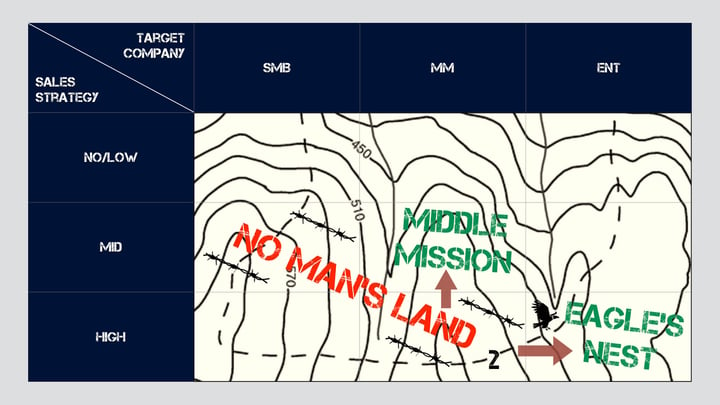
If you’re located in Position 2 then you also have two ways out. Firstly, you could gravitate towards the Middle Mission and alter your sales strategy from high-touch enterprise to more applicable mid-touch processes.
The other option would be to shift your focus from mid-market to enterprise companies.
Based on HubSpot’s example, maintaining their sales strategy whilst altering their focus worked for them, so you may be best off switching to an enterprise focus rather than changing your sales processes.
The trade-off of longer-time-to-close for a higher ARPA is probably the one that is worth it in this case, especially since your existing sales team will be well equipped to conquer the Eagle’s Nest.
6. Suicide Mission
And so we come to our penultimate mission. It’s not ugly, but it sure isn’t pretty.
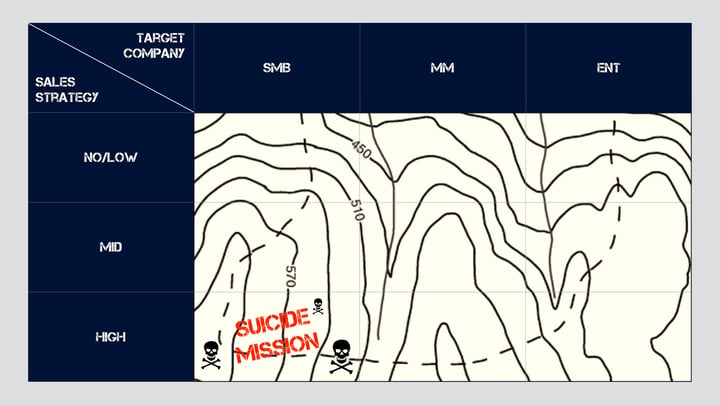
- Sales Strategy = High Touch
- Target Company = SMB
- ARPA = Low
- CAC = High
Mission Objective
Sell to SMBs with a high-touch sales strategy.
Mission Overview...
If you are selling your SaaS product to startups and small businesses with a high-touch sales process then you are going to kill your company. And that’s precisely why it’s called a Suicide Mission.
Your ecosystem is completely out of balance as your sales strategy and target company are entirely misaligned, which will lead to chaos when it comes to channel acquisition, pricing, and business model; do you satisfy the needs of the high-touch sales process or the low ARPA customer? Or somewhere in between?
The issue here is that no answer is ideal, so you must immediately abort the mission and move to a new position within the matrix.
How can I escape a Suicide Mission?
All escape routes up until this point have only required one degree of flex. By this, I mean that you have been able to move into a position of safety by altering your target company or the sales strategy you’re employing.
But in order to escape the Suicide Mission then you need to cross over No Man’s Land, which gives you three possible alternatives, but each requires two degrees of flex in your strategy.
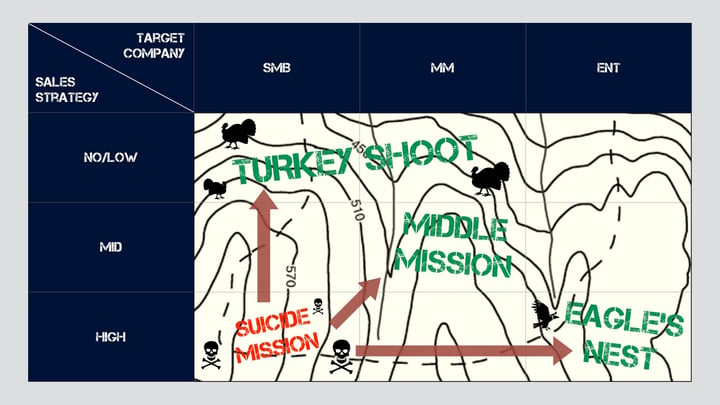
The first is to completely alter your sales strategy to match the SMB buyers and join the Turkey Shoot. This means automating everything, lowering your price, and seeking a high volume of low ARPA users that you gain via low CAC tactics.
The second is to completely shift your focus to Enterprise accounts and modify your pricing accordingly to match your high-touch sales efforts; you need to switch your focus from lots of turkeys to a few big eagles.
And the third is to pivot slightly in both directions and target the mid-market with a slightly lessened sales focus that relies on elements of automation and sophisticated inbound marketing practices.
You will also need to alter your pricing and model in a similar way Balfour did with HubSpot’s sidekick, but a Middle Mission is one of your possible alternatives.
Ultimately if you are selling to low ARPA SMBs with a high-touch sales process then you must urgently change your strategy.
The Ugly
7. Carpet Bomb Mission
We’ve seen the good, the bad, and here comes the ugly.
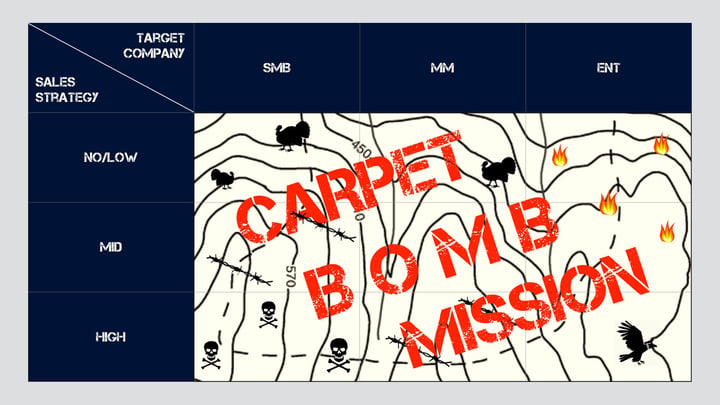
At the beginning of this post, we stated that one of the biggest mistakes a SaaS company can make is thinking they can sell to everyone. That’s exactly the point we want to emphasize with the final mission, the Carpet Bomb.
Carpet bombing is a military tactic used to inflict damage to a large area without a specific target in mind. This same analogy applies to SaaS companies who have failed to clearly define a specific target; they will try and sell to anyone, which ultimately leads to no one.
As we’ve found, different markets require products, which require different acquisition channels, which in turn require different pricing and business models. All components need to sing in perfect harmony otherwise you will lead your team on a failed mission.
If you find yourself on a Carpet Bomb Mission then you need to start by defining a market problem and position your product as a solution to this issue.
This will provide the foundation for your market-product fit and establish your position in the matrix, which in turn will allow you to define the right channels, models, and growth tactics to ensure a well-balanced ecosystem.
Mapping Your Competition: A Case From Marketing Automation
The Mission Matrix also serves as a way to map the position of your competitors, allowing you to differentiate your offering.
Let’s take a short example from the field of marketing automation.
GetReponse, HubSpot, and Marketo all provide a similar solution to the same problem; an automation platform for marketers, salespersons, and growth teams to build their funnels, sales pipelines, and businesses.
Yet despite all three companies having the same product-market fit, they have all established different market-product fits. This means each of the three companies occupies a different mission within the matrix.
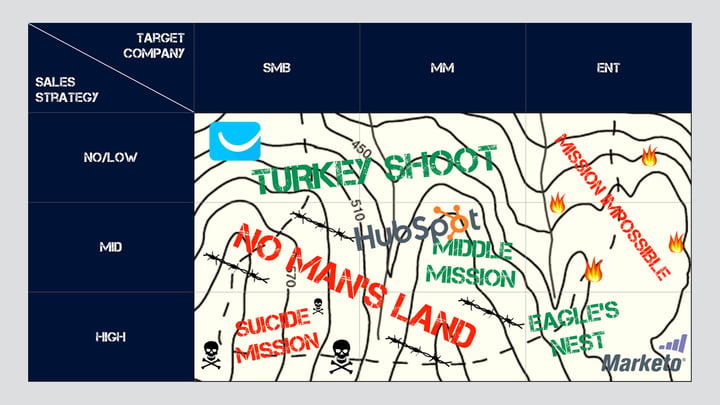
GetResponse started life as an email marketing platform but they have expanded their offering to include basic automation and inbound marketing functionality. They operate a no/low-touch sales model that is heavily automated with a low ARPA and low CAC. They operate a Turkey Shoot mission.
HubSpot has a more holistic growth stack solution that encompasses marketing, sales, and a CRM. They use a combination of freemium, free trial, and automated models with a strong mid-touch sales unit comprised of account managers, channel managers, inside sales reps, and a comprehensive partner program. Their pricing is in the mid-ARPA with a corresponding CAC and HubSpot is very much running a Middle Mission.
Marketo is the third player in this example and they have built a solution for large and complex enterprise-level customers. There is no pricing page on their website (contact them if you want a quote) and their acquisition channels and business model align with their market-product fit. Dollar to dollar they are by far the most ‘expensive’ option, but that’s because they’re targeting the Eagle’s Nest.
As we can see, all three can co-exist since they are running different missions despite solving the same basic problem. The fight for customers happens at the borders of each mission; GetResponse and HubSpot will battle over large SMBs whilst HubSpot and Marketo will battle over large mid-market and small enterprise customers.
Mission Debrief
What should I do next? Here’s a step-by-step checklist to ensure you’re well-positioned for sustainable SaaS success:
- Establish your position within The Mission Matrix
- If you are running a dangerous mission then follow the steps to get out of danger and move into a strategic position of safety
- If you are running a positive mission then map your competitors to understand your role within the field
- Clearly identify whether your existing position is best for long-term sustainable success, if not think where you would need to move to within the matrix
- Make sure you have a clear market-product fit and that your ecosystem is in balance regarding channel acquisition and business model and pricing
- Constantly improve your growth tactics to scale up your business successfully
---
And that concludes The Mission Matrix.
As you can see, the model has been built for both early-stage B2B SaaS companies looking to define their strategic positioning, as well as more established B2B SaaS companies to help ensure they’re strategically well placed for success alongside guidance on how to move from a poor strategic position to a more sustainable one.
Hopefully, you will find this helpful and we’d love to hear your thoughts on the model. Do you agree with it? What could be done to improve the model? Are there some viewpoints we overlooked? Let us know on Twitter!
To find out more about us or get awesome pieces of content like this straight to your inbox, you can get in touch with us or become an Advance Insider. It's like a newsletter but better —we’ll email you about our newest podcast episodes, blog posts, and/or roundup opportunities.

